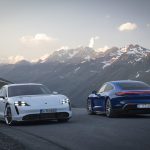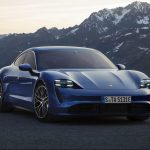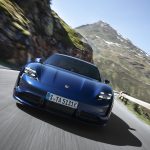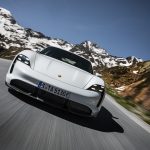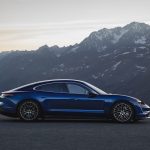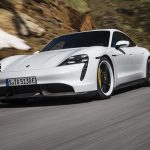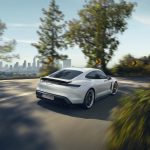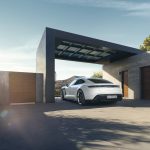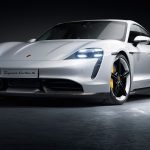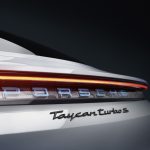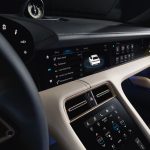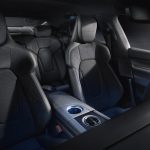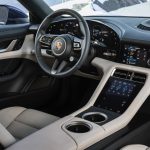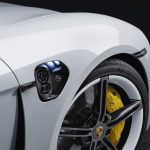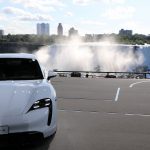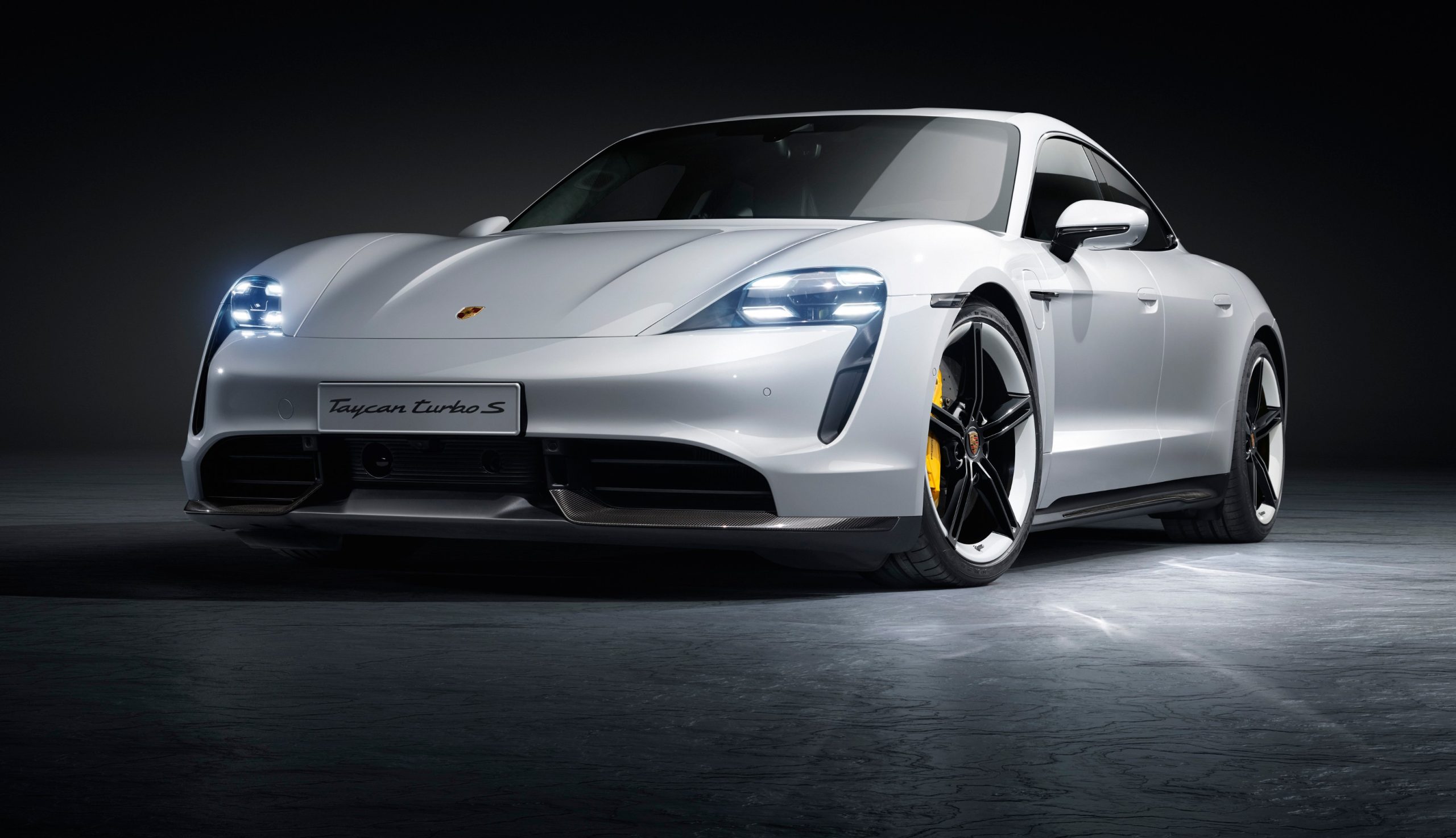
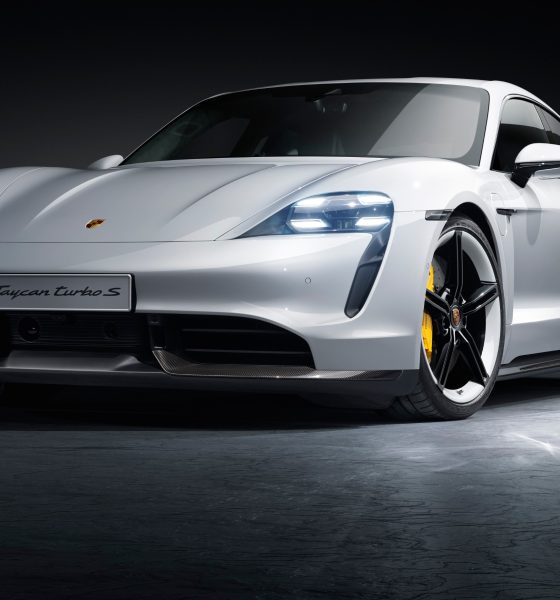
News
Porsche Taycan is here: 0-60 mph in 2.6 sec, 750 HP, good looks with a 911 price tag
The Porsche Taycan is here. In three simultaneous events in Canada, Germany, and China, the veteran automaker took the wraps off its first all-electric sports car. Addressing the audience at Niagara Falls, Porsche Executive Board Member for Sales and Marketing Detlev von Platen highlighted the importance of the Taycan to the company, particularly as it is a vehicle that is designed to carry Porsche into the electric age.
“The Taycan links our heritage to the future. It carries forward the success story of our brand – a brand that has fascinated and thrilled people the world over for more than 70 years. This day marks the start of a new era,” he said.
Porsche will be starting its electric car push with the Taycan’s top two configurations: the Taycan Turbo and the Taycan Turbo S. The base Taycan, as well as the midrange Taycan 4S, are expected to follow later this year, while the vehicle’s first derivative, the outdoor-themed Taycan Cross Turismo, is poised to be launched by the end of 2020. The company noted that by 2022, it would have invested over $6.6 billion in its electric vehicle initiatives.
Following is an overview of the Taycan’s characteristics, from its design and performance to its safety features and price.
- Photography: Christoph Bauer Postproduction: Wagnerchic – www.wagnerchic.com
- Photography: Christoph Bauer Postproduction: Wagnerchic – www.wagnerchic.com
- Photography: Christoph Bauer Postproduction: Wagnerchic – www.wagnerchic.com
- Photography: Christoph Bauer Postproduction: Wagnerchic – www.wagnerchic.com
- Photography: Christoph Bauer Postproduction: Wagnerchic – www.wagnerchic.com
The Porsche Taycan Turbo and the Taycan Turbo S. (Credit: Porsche AG)
Design
Immediately noticeable from the production version of the Taycan is that the vehicle is very close to the appearance of the Mission E sedan. The Taycan is 1,966 mm (77.4 inches) wide but only 1,380 mm (54.33 inches) high, which gives the car a wide and flat look that is distinctly Porsche. It’s very low to the ground, being 40 mm (1.5 inches) lower than the Panamera. From the rear, the Taycan is shaped by a roofline that slopes downward to the rear, while its side sections are highly sculpted, giving the vehicle a wide and sporty stance. Overall, the Taycan has a length of 4,963 mm (195.39 inches) and a wheelbase of 2,900 mm (114.17 inches). The vehicle also has a 0.22 drag coefficient, which is currently the lowest of all cars Porsche has released to date.
Performance
Porsche has only revealed the performance figures of the Taycan Turbo and Turbo S. With Launch Control, the Taycan Turbo S is capable of going from 0 to 60 mph in 2.6 seconds. The Taycan Turbo is only a fraction of a second behind, with its 0-60 mph time of 3.0 seconds. Quarter-mile times for each vehicle stand at 10.8 seconds for the Taycan Turbo S and 11.1 seconds for the Taycan Turbo.
The secret to the Taycan’s speed lies in its two electric motors, the front of which has a max output of 190 kW for the Turbo S and 175 kW for the Turbo. The Taycan’s 335 kW rear motor, as well as its dedicated Launch Mode options with “Overboost,” ultimately allows the Taycan to have a maximum torque of 1,050 Nm for the Turbo S and 850 Nm for the Turbo variant.
- Photography: Christoph Bauer Postproduction: Wagnerchic – www.wagnerchic.com
- The Porsche Taycan Turbo S. (Credit: Christoph Bauer Postproduction: Wagnerchic – www.wagnerchic.com)
- Photography: Christoph Bauer Postproduction: Wagnerchic – www.wagnerchic.com
- (Credit: Porsche AG)
The Porsche Taycan Turbo and the Taycan Turbo S. (Credit: Porsche AG)
Safety
The Taycan’s body is comprised of an aluminum chassis reinforced with hot-formed steel on pillars and doors. Porsche highlighted that the vehicle was designed with strict requirements to ensure that nothing can puncture the car’s battery pack. In the event of a frontal crash, the Taycan’s front assemblies slide away from the pack to prevent intrusions into the cabin. The Taycan is equipped with a suite of sensors as well, including front and rear radar, wide-angle cameras, a mono front camera, ultrasonic sensors, and long-range radar.
Battery
Porsche opted to utilize a 100 kWh battery pack with the Taycan, though only 93 kWh of this is usable. The Taycan’s batteries are made from Li-ion pouch cells that are provided by LG Chem. The Taycan’s aluminum battery pack has a 2 mm thickness on the bottom, with cell modules resting on top of the cooling system on the battery pack.
The automaker utilized its 800-volt architecture for the Taycan, which, Porsche noted, reduces the current needed to produce large amounts of power. The lower current also means that Porsche could use thinner cables for the vehicle, allowing the Taycan’s wiring system to be lighter. Ultimately, Porsche notes that the Taycan’s 800-volt tech enables higher continuous power and faster charging.
- Photography: Christoph Bauer Postproduction: Wagnerchic – www.wagnerchic.com
- The Porsche Taycan unveiled. (Photo: Sean Mitchell/Teslarati)
The Porsche Taycan Turbo and the Taycan Turbo S. (Credit: Porsche AG)
Range
The Porsche Taycan has not been issued with an official EPA rating yet, though the Turbo S has been given a 388–412 km (241-256 miles) range per charge under the WLTP standard. The Taycan Turbo was given a higher max range rating by the WLTP, outlasting its more powerful sibling with an estimated range of 381-450 km (236.74-279.61 miles) per charge.
The Taycan Turbo has a power consumption of 25.7–24.5 kWh/100 km under the WLTP, which makes it more efficient compared to the Taycan Turbo S’ 26.7–23.0 kWh/100 km. Overall, the Taycan Turbo has a combined power consumption rating of 26.0 kWh/100 km under the NEDC, while the Turbo S variant is rated at 26.9 kWh/100 km.
Features
The Porsche Taycan’s storage area is comprised of a rear trunk and a frunk. According to the vehicle’s official spec sheet released for North America, the Taycan’s frunk has 2.8 cubic feet of space, while its rear trunk has 12.9 cubic feet of space. The Taycan is also equipped with two charging ports. Interestingly, the Taycan has a nifty feature for times when its charging port door is stuck due to ice. In such instances, the Taycan’s charge port door will vibrate and gradually increase the force until the vibrations break the ice. This should help electric car owners charge their vehicles during winters.
Price
Porsche states that the Taycan is one of its most important vehicles since the 911. In this sense, the Taycan is priced in pretty much the same bracket as the flagship sports car. The Taycan Turbo starts at $150,900 ($153,310 at launch), which is comparable to the price of a 2019 Porsche 911 Turbo. For comparison, Porsche Fremont’s official website lists the 2019 911 Turbo with an MSRP of $161,800.
The Taycan Turbo S is Porsche’s flagship electric car to date, and it is priced as such. The vehicle starts at $185,000 ($187,610 at launch), making it comparable to the price of a 2019 Porsche 911 Turbo S, which is listed in the United States with an MSRP of $190,700.
Watch the Porsche Taycan’s unveiling in the video below.

News
Tesla refines Full Self-Driving, latest update impresses where it last came up short
We were able to go out and test it pretty extensively on Saturday, and the changes Tesla made from the previous version were incredibly impressive, especially considering it seemed to excel where it last came up short.

Tesla released Full Self-Driving v14.2.1.25 on Friday night to Early Access Program (EAP) members. It came as a surprise, as it was paired with the release of the Holiday Update.
We were able to go out and test it pretty extensively on Saturday, and the changes Tesla made from the previous version were incredibly impressive, especially considering it seemed to excel where it last came up short.
Tesla supplements Holiday Update by sneaking in new Full Self-Driving version
With Tesla Full Self-Driving v14.2.1, there were some serious regressions. Speed Profiles were overtinkered with, causing some modes to behave in a strange manner. Hurry Mode was the most evident, as it refused to go more than 10 MPH over the speed limit on freeways.
It would routinely hold up traffic at this speed, and flipping it into Mad Max mode was sort of over the top. Hurry is what I use most frequently, and it had become somewhat unusable with v14.2.1.
It seemed as if Speed Profiles should be more associated with both passing and lane-changing frequency. Capping speeds does not help as it can impede the flow of traffic. When FSD travels at the speed of other traffic, it is much more effective and less disruptive.
With v14.2.1.25, there were three noticeable changes that improved its performance significantly: Speed Profile refinements, lane change confidence, and Speed Limit recognition.
🚨 Many of you asked us to test highway driving with Tesla Full Self-Driving v14.2.1.25. Here’s what we noticed:
✅ Speed Profiles are significantly improved. Hurry Mode is no longer capped at 10 MPH over the speed limit, and now travels with the flow of traffic. This is much… pic.twitter.com/48ZCGbW0JO
— TESLARATI (@Teslarati) December 13, 2025
Speed Profile Refinement
Speed Profiles have been significantly improved. Hurry Mode is no longer capped at 10 MPH over the speed limit and now travels with the flow of traffic. This is much more comfortable during highway operation, and I was not required to intervene at any point.
With v14.2.1, I was sometimes assisting it with lane changes, and felt it was in the wrong place at the wrong time more frequently than ever before.
However, this was one of the best-performing FSD versions in recent memory, and I really did not have any complaints on the highway. Speed, maneuvering, lane switching, routing, and aggressiveness were all perfect.
Lane Changes
v14.2.1 had a tendency to be a little more timid when changing lanes, which was sort of frustrating at times. When the car decides to change lanes and turn on its signal, it needs to pull the trigger and change lanes.
It also changed lanes at extremely unnecessary times, which was a real frustration.
There were no issues today on v14.2.1.25; lane changes were super confident, executed at the correct time, and in the correct fashion. It made good decisions on when to get into the right lane when proceeding toward its exit.
It was one of the first times in a while that I did not feel as if I needed to nudge it to change lanes. I was very impressed.
Speed Limit Recognition
So, this is a complex issue. With v14.2.1, there were many times when it would see a Speed Limit sign that was not meant for the car (one catered for tractor trailers, for example) or even a route sign, and it would incorrectly adjust the speed. It did this on the highway several times, mistaking a Route 30 sign for a 30 MPH sign, then beginning to decelerate from 55 MPH to 30 MPH on the highway.
This required an intervention. I also had an issue leaving a drive-thru Christmas lights display, where the owners of the private property had a 15 MPH sign posted nearly every 200 yards for about a mile and a half.
The car identified it as a 55 MPH sign and sped up significantly. This caused an intervention, and I had to drive manually.
It seems like FSD v14.2.1.25 is now less reliant on the signage (maybe because it was incorrectly labeling it) and more reliant on map data or the behavior of nearby traffic.
A good example was on the highway today: despite the car reading that Route 30 sign and the Speed Limit sign on the center screen reading 30 MPH, the car did not decelerate. It continued at the same speed, but I’m not sure if that’s because of traffic or map data:
🚨 We listened to and read a lot of you who had a complaint of Tesla Full Self-Driving v14.2.1 incorrectly reading Speed Limit signs
This appears to be resolved in v14.2.1.25.
Here’s a breakdown: pic.twitter.com/TEP03xrMbt
— TESLARATI (@Teslarati) December 13, 2025
A Lone Complaint
Tesla has said future updates will include parking improvements, and I’m really anxious for them, because parking is not great. I’ve had some real issues with it over the past couple of months.
Today was no different:
🚨 My lone complaint with my drive on Tesla FSD v14.2.1.25 was this strange parking instance.
FSD swung out wide to the left to pull into this spot and this is where it seemed to be stumped. I gave it about 10 seconds after the car just stopped moving for it to make some… https://t.co/ZEkhTHOihG pic.twitter.com/TRemXu5DLf
— TESLARATI (@Teslarati) December 13, 2025
Full Self-Driving v14.2.1.25 is really a massive improvement over past versions, and it seems apparent that Tesla took its time with fixing the bugs, especially with highway operation on v14.2.1.
News
Tesla hints at Starlink integration with recent patent
“By employing polymer blends, some examples enable RF transmission from all the modules to satellites and other communication devices both inside and outside the vehicle.”

Tesla hinted at a potential Starlink internet terminal integration within its vehicles in a recent patent, which describes a vehicle roof assembly with integrated radio frequency (RF) transparency.
The patent, which is Pub. No U.S. 2025/0368267 describes a new vehicle roof that is made of RF-transparent polymer materials, allowing and “facilitating clear communication with external devices and satellites.”
Tesla believes that a new vehicle roof design, comprised of different materials than the standard metallic or glass elements used in cars today, would allow the company to integrate modern vehicular technologies, “particularly those requiring radio frequency transmission and reception.
Tesla has recently filed a US patent application on integrating RF transparent materials into the roof structure.
“facilitating clear communication with external devices and satellites”
Tesla fleet is getting @Starlink connectivity integration soon. LFG @Tesla @elonmusk… pic.twitter.com/bLa8YtPLd1
— Chansoo Byeon (@Chansoo) December 9, 2025
Instead of glass or metallic materials, Tesla says vehicles may benefit from high-strength polymer blends, such as Polycarbonate, Acrylonitrile Butadiene Styrene, or Acrylonitrile Styrene Acrylate.
These materials still provide ideal strength metrics for crashworthiness, stiffness for noise, vibration, and harshness control, and are compliant with head impact regulations.
They would also enable better performance with modern technologies, like internet terminals, which need an uninterrupted signal to satellites for maximum reception. Tesla writes in the patent:
“By employing polymer blends, some examples enable RF transmission from all the modules to satellites and other communication devices both inside and outside the vehicle.”

One of the challenges Tesla seems to be aware of with this type of roof design is the fact that it will still have to enable safety and keep that at the forefront of the design. As you can see in the illustration above, Tesla plans to use four layers to increase safety and rigidity, while also combating noise and vibration.
It notes in the patent that disclosed examples still meet the safety requirements outlined in the Federal Motor Vehicle Safety Standards (FMVSS).
Starlink integrated directly into Tesla vehicles would be a considerable advantage for owners. It would come with a handful of distinct advantages.
Initially, the inclusion of Starlink would completely eliminate cellular dead zones, something that is an issue, especially in rural areas. Starlink would provide connectivity in these remote regions and would ensure uninterrupted service during road trips and off-grid adventures.
It could also be a critical addition for Robotaxi, as it is crucial to have solid and reliable connectivity for remote monitoring and fleet management.
Starlink’s growing constellation, thanks to SpaceX’s routine and frequent launch schedule, will provide secure, stable, and reliable internet connectivity for Tesla vehicles.
Although many owners have already mounted Starlink Mini dishes under their glass roofs for a similar experience, it may be integrated directly into Teslas in the coming years, either as an upgrade or a standard feature.
News
Tesla supplements Holiday Update by sneaking in new Full Self-Driving version
It seems Tesla was waiting for the Hardware 4 rollout, as it wanted to also deploy a new Full Self-Driving version to those owners, as it appeared in the release notes for the Holiday Update last night.

Tesla has surprised some owners by sneaking in a new Full Self-Driving version with the wide release of the Holiday Update, which started rolling out to Hardware 4 owners on Friday night.
Tesla has issued a controlled and very slow release pattern with the Holiday Update, which rolls out with Software Version 2025.44.25.5.
For the past two weeks, as it has rolled out to Hardware 3 and older Tesla owners, the company has kept its deployment of the new Software Version relatively controlled.
It seems Tesla was waiting for the Hardware 4 rollout, as it wanted to also deploy a new Full Self-Driving version to those owners, as it appeared in the release notes for the Holiday Update last night.
Tesla Full Self-Driving v14.2.1.25 made its first appearance last night to Hardware 4 owners who are members of the Early Access Program (EAP). It appears to be a slight refinement from FSD v14.2.1, which has been out for a couple of weeks.
Tesla v2025.44.25.5 Holiday update incoming
Also Full Self-Driving v14.2.1.25!!! pic.twitter.com/74D7S0UGXz
— TESLARATI (@Teslarati) December 13, 2025
Many owners welcome the new FSD version, us included, because we’ve been less than impressed with v14.2.1. We have experienced some minor regressions with v14.2.1, especially with Speed Limit recognition, Speed Profile tinkering, and parking performance.
As it stands, Full Self-Driving is still particularly impressive, but Tesla is evidently having an issue with some of the adjustments, as it is still refining some of the performance aspects of the suite. This is expected and normal with some updates, as not all of them are an improvement in all areas; we routinely see some things backtrack every once in a while.
This new FSD version is likely to take care of those things, but it also includes all of the awesome Holiday Update features, which include:
- Grok with Navigation Commands (Beta) – Grok will now add and edit destinations.
- Tesla Photobooth – Take pictures inside your car using the cabin-facing camera
- Dog Mode Live Activity – Check on your four-legged friend on your phone through periodic snapshots taken of the cabin
- Dashcam Viewer Update – Includes new metrics, like steering wheel angle, speed, and more
- Santa Mode – New graphics, trees, and a lock chime
- Light Show Update – Addition of Jingle Rush light show
- Custom Wraps and License Plates – Colorizer now allows you to customize your vehicle even further, with custom patterns, license plates, and tint
- Navigation Improvements – Easier layout and setup
- Supercharger Site Map – Starting at 18 pilot locations, a 3D view of the Supercharger you’re visiting will be available
- Automatic Carpool Lane Routing – Navigation will utilize carpool lanes if enabled
- Phone Left Behind Chime – Your car will now tell you if you left a phone inside
- Charge Limit Per Location – Set a charge limit for each location
- ISS Docking Simulator – New game
- Additional Improvements – Turn off wireless charging pad, Spotify improvements, Rainbow Rave Cave, Lock Sound TRON addition
Tesla also added two other things that were undocumented, like Charging Passport and information on USB drive storage to help with Dashcam.
